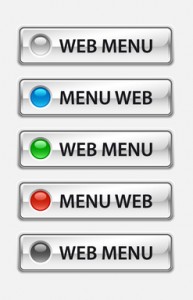We humans are now exposed to more information every minute of every day than we can possibly cope with – in fact, our brains have had to develop complex selection strategies to avoid a total meltdown. Fact.
When it comes to email marketing or copy writing for websites, the more structure you can offer the reader, the greater the chances of your message getting through. So, once you have your prospect’s attention, you need to make it very clear what you want from them and fast! “How do you do this?” we hear you cry. Why, with a big colourful button.
What’s in it for them?
Today, with so many marketing messages in written form, most of us have become proficient skim readers. So don’t expect your audience to be poring over the subtleties of your text, making notes and performing a critical analysis. Imagine instead your readers hurtling through the message whilst a dozen other things compete for their attention.
The reality is that the whole time they are reading your message, prospects will be asking two key questions: ‘What’s in it for me?’ and ‘What should I do next?’
Give them a clear call to action
A ‘call to action’ is a clear indication of what you want someone to do next and a big colourful button is a great way to do this. Make your instruction obvious, short and descriptive. Something along the lines of ‘Find out more’, ‘Book tickets’ or ‘Buy now’.
The aim is to get them clicking, so if the offer is time sensitive, make sure you create a sense of urgency with your wording.
-
How to present your call to action
Each call to action needs to stand out visually in the context of your campaign design, naturally drawing the eye of the skim reader. Buttons are generally the easier option if you’re using a CMS website or email marketing system, but you could also try using photos with overlaid text. If you’re less confident with graphics then you could use simple text links – but don’t go overboard with these as they can cheapen websites and upset spam filters! -
Where to put your call to action
Somewhere prominent! Readers will not go searching for your call to action so there is no use in tucking it away. Keep your text short and to the point, using your calls to action to direct interested parties to more information elsewhere on your website. -
Be clear on your objective
With each call to action, it is essential to remain focused on what you are trying to achieve. Is it a click through from an email marketing campaign or a request for more social media followers? If it is a downloadable link on your website, should you be asking for the user’s details before giving your information away? (The answer is ‘yes’ by the way.) -
How to test
To maximise the effectiveness of your calls to action, you should perform some testing on your email campaigns and study your website metrics to see what yields the best results. Use split testing to try out different wording, graphics or placing of your calls to action (although do not change all those things in one go!).
What kinds of calls to action have you had the most success with? Let us know by posting a reply below!
